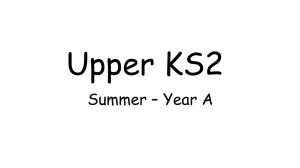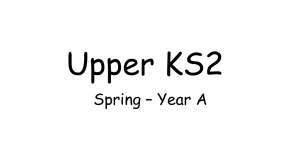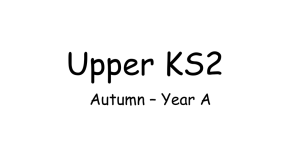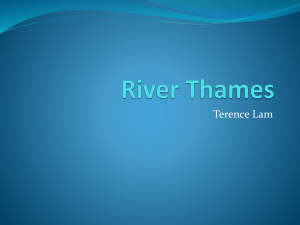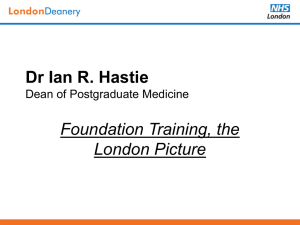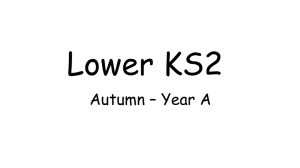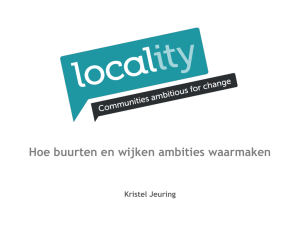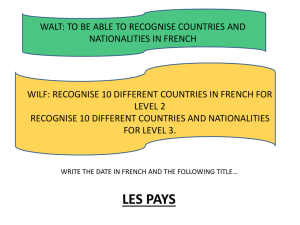LKS2 Year A Summer
advertisement
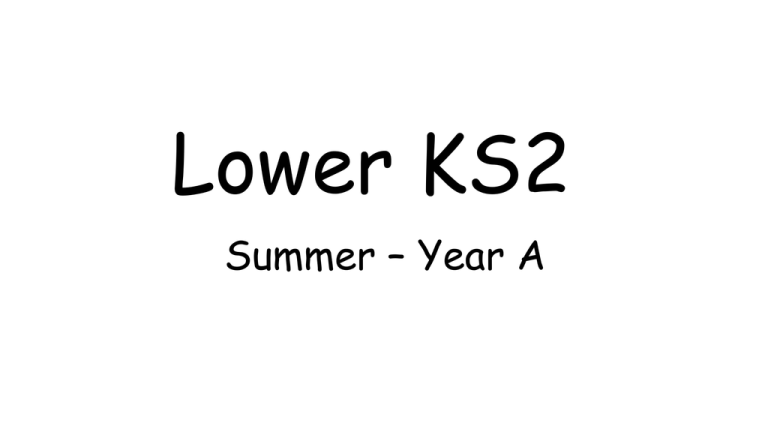
Lower KS2 Summer – Year A Science Year 4: Which wild animals and plants will we find in your locality? Year 4: Science, Art and DT Knowledge, Skills and Understanding Year 4 Science: All Living Things • • • • • • • • • • • • Art & Design Can they take measurements using different equipment and units of measure and record what they have found in a range of ways? Can they make accurate measurements using standard units? Can they explain their findings in different ways (display, presentation, writing)? Can they find any patterns in their evidence or measurements? Can they make a prediction based on something they have found out? Can they record and present what they have found using scientific language, drawings, labeled diagrams, bar charts and tables? Can they use a classification key to group a variety of living things? (plants, vertebrates, invertebrates) Can they compare the classification of common plants and animals to living things found in other places? (under the sea, prehistoric) Can they name and group a variety of living things based on feeding patterns? (producer, consumer, predator, prey, herbivore, carnivore, omnivore) • • • • • • • Can they create all the colours they need? Can they create mood in their paintings? Do they successfully use shading to create mood and feeling? Can they use their sketch books to express their feelings about various subjects and outline likes and dislikes? Can they produce a montage all about themselves? Do they use their sketch books to adapt and improve their original ideas? Do they keep notes about the purpose of their work in their sketch books? Design Technology • • • • • • Year 4 Challenging • Can they record more complex data and results using scientific diagrams, classification keys, tables, bar charts, line graphs and models? Can they report findings from investigations through written explanations and conclusions? Can they use a graph or diagram to answer scientific questions? • • • Can they come up with at least one idea about how to create their product? Do they take account of the ideas of others when designing? Can they produce a plan and explain it others? Can they suggest some improvements and say what was good and not so good about their original design? Can they tell if their finished product is going to be good quality? Are they conscious of the need to produce something that will be liked by others? Can they show a good level of expertise when using a range of tools and equipment? Have they thought of how they will check if their design is successful? Can they begin to explain how they can improve their original design? Can they evaluate their product, thinking of both appearance and the way it works? © Focus Education 2014 3 Year 4: Which wild animals and plants thrive in your locality? Science Y4: Living Things and their Habitats • • • recognise that living things can be grouped in a variety of ways explore and use classification keys to help group, identify and name a variety of living things in their local and wider environment recognise that environments can change and that this can sometimes pose dangers to living things. WOW: Visit to a Garden Centre Working Scientifically: explore local small invertebrates and using guides or keys to identify them; making a guide to local living things; raising and answering questions based on their observations of animals and what they have found out about other animals that they have researched. LC1 Which wild flowers will we find within a Km of our school? Literacy Link: Develop fact files about wild flowers and endangered animals LC2 How would Georgia O’Keefe have painted these flowers? Numeracy Link: Classification of plants and birds, leading to graphs and tables LC3 Would dinosaurs have roamed around your locality in the past? LC4 Why did dinosaurs die out? LC5 Why are there large wild animals like the tiger in danger of extinction today? Creative Art Link: Taking photographs of flowers in the manner that Georgia O’Keefe would have done. • Develop pencil sketches from the photographs • Paint – water colour or acrylic LC6 Which birds can we see out of our classroom window? LC7 How can we encourage more birds to visit our school? LC8 Creative Art Link: Designing and making a bird box which will be used to help attract birds to the immediate area around the school Reflection: Can you create a documentary about saving a species of your choice. © Focus Education 2014 Fox Margaret Wild & Ron Brooks 4 Investigations Module History Year 4 History Knowledge, Skills and Understanding Chronological understanding Knowledge and interpretation Historical enquiry • Can they plot recent history on a timeline using centuries? • Can they place periods of history on a timeline showing periods of time? • Can they use their mathematical skills to round up time differences into centuries and decades? • Can they explain how events from the past has helped shape our lives? • Can they recognise how lives in the past are different from ours? • Do they know that people who lived in the past cooked and travelled differently and used different weapons from ours? • Do they recognise that the lives of wealthy people were very different from those of poor people? • Do they appreciate how items found belonging to the past are helping us to build up an accurate picture of how people lived in the past? • Can they research two versions of an event and say how they differ? • Can they give more than one reason to support an historical argument? • Can they communicate knowledge and understanding orally and in writing and offer points of view based upon what they have found out? Year 4 (Challenging) • Can they use their mathematical skills to help them work out the time differences between certain major events in history? • Can they begin to build up a picture of what main events happened in Britain/ the world during different centuries? • Can they recognise that people’s way of life in the past was dictated by the work they did? • Do they appreciate that wealthy people would have had a very different way of living which would have impacted upon their health and education? • Can they independently, or as part of a group, present an aspect they have researched about a given period of history using multi-media skills when doing so? Year 4 Music Knowledge, Skills and Understanding • • • • • • Can they perform a simple part rhythmically? Can they sing songs from memory with accurate pitch? Can they improvise using repeated patterns? Can they start to identify the character of a piece of music? Can they describe and identify the different purposes of music? Can they begin to identify with the style of work of significant British musicians? © Focus Education 2014 Year 4: What would you have done after school 100 years ago? KS2 History: Leisure and Entertainment in the 20th century WOW: All children start the day by being introduced to traditional board games such as: ludo; snakes and ladders, etc. LC1 How would you have coped without television and the iPad? LC2 How was leisure and entertainment different for rich and poor children 100 years ago? LC3 Would you have been able to go to McDonald’s for your birthday party 100 years ago? LC4 What would your favourite football team have looked like 100 years ago? LC5 How could you create your own ‘Silent Movie’? LC6 What would ‘Top of the Pops’ have been like 100 years ago? LC7 Reflection: Children to create a documentary on life for children 100 years ago focusing on leisure and entertainment Literacy Link: Huge opportunities in LC1 for children to consider what life would be like without television and electronic gadgets. LC2 provides research opportunities for children to find out about what rich children would have had in comparison to poor ones. LC3 provides children with a chance to find out about how children would have celebrated birthdays and Christmas. LC4 provides children with good opportunities to research what footballers would have worn and then to find out about how much it would have cost to watch them play, etc. Use old football, programmes to find out more about life from the adverts, etc. IT Presentation: During LC5 children will have to write and produce their own silent movie and film it. Further opportunities for IT presentation offered in LC6 Expressive Link: During LC6 children will find out about the popular songs of the era and then create their own video dressed appropriately for the time. © Focus Education 2014 Chimney Child Laurie Sheehan 8 Geography Year 4 Geography Knowledge, Skills and Understanding Geographical Enquiry Physical Geography Human Geography • Can they carry out a survey to discover features of cities and villages? • Can they find the same place on a globe and in an atlas? • Can they label the same features on an aerial photograph as on a map? • Can they plan a journey to a place in England? • Can they accurately measure and collect information(e.g. rainfall, temperature, wind speed, noise levels etc.)? • Can they describe the main features of a well-known city? • Can they describe the main features of a village? • Can they describe the main physical differences between cities and villages? • Can they use appropriate symbols to represent different physical features on a map? • Can they explain why people are attracted to live in cities? • Can they explain why people may choose to live in a village rather than a city? • Can they explain how a locality has changed over time with reference to human features? • Can they find different views about an environmental issue? What is their view? • Can they suggest different ways that a locality could be changed and improved? Geographical Knowledge • Do they know the difference between the British Isles, Great Britain and UK? • Can they name up to six cities in the UK and locate them on a map? • Can they name the areas of origin of the main ethnic groups in the UK & in their school? Year 4 (Challenging) • Can they give accurate measurements between 2 given places within the UK? • Can they explain how a locality has changed over time with reference to physical features? • Can they explain how people are trying to manage their environment? © Focus Education 2014 • Can they name the counties that make up the home counties of London? 10 Year 4:Why is the *Thames so important to London? **Alternative to ‘Where would you choose to build a city?’ KS2 Geography: Settlements, land use, economic activity, including natural resources, especially energy and water supplies WOW: Ideally a boat trip down the Thames Literacy Link: LC1 and LC2 provide opportunities for children to carry out their own research History Link: Opportunities for research into London over the past 100 year or so. This would involve looking at old maps, etc. LC1 Why is London situated where it is? LC2 Which other famous European cities are situated on a river? LC3 Why are rivers important for the lives of the people who live there now and lived there some time ago? LC4 How have people adapted rivers and water for their own use? LC5 How has the Thames created jobs for many people who live in London? LC6 Using your photographs, can you create a painting of one of the bridges on the Thames? LC7 Which pieces of music are associated with London or water? LC8 Reflection: Groups of children to put together a photostory of their learning about London Creative Art Link: LC6 provides opportunities for children to look at the work of famous artists and to use water colour or washes to create landscape paintings to include the River Thames. Expressive Art Link: LC7 provides opportunities for children to think of/ perform the music associated with London or with water. Settlements of the Thames © Focus Education 2014 Rob Bowden The Nile River in The Sand Molly Aloian *This Learning Challenge could be adapted to the River Mersey or Tyne or any other major UK river and city. 11
